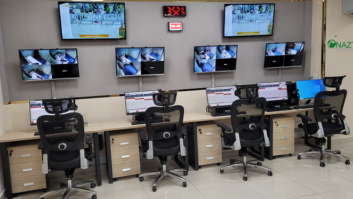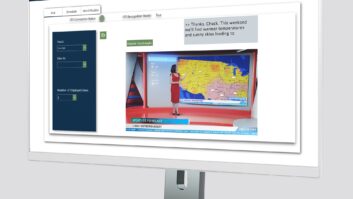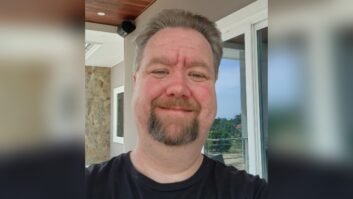Translator Pioneer Howard Enstrom Reflects On a Long Career and Service to God
Who’s the “father of FM radio”? That’s easy; Major Edwin Howard Armstrong’s invention of FM capped a career that also gave the world superheterodyne and regenerative receivers.
But what about FM translators, those little relay transmitters that brought distant programming into small towns that couldn’t support stations of their own?
The Media Preservation Foundation has stated that many people consider Howard L. Enstrom to be “the father of translator service.” Enstrom, now 82, remains opinionated about the current state of the FM dial.
Long before the advent of translators, Enstrom was an accomplished broadcaster in several arenas.
He was born in 1922 in Chicago. During the Depression, as a teen, he built receivers and transmitters using discarded radios; he earned his first amateur license at age 15.
Early in World War II he worked for the U.S. Army Signal Corps as a field inspector, examining new technology – including FM two-way radios – built for the war effort. Enstrom then joined the Navy in 1943, where he attended Electronic Instrument School, maintained minesweepers and saw combat in the Battle of Okinawa.
He talks of watching Japanese kamikaze planes attacking his ship, of being shipwrecked in a typhoon and of committing his life to Christ as a result.
“God answered my fervent prayer to survive and allow me to serve Him.”
After the war, Enstrom went to work for Chicago’s Moody Bible Institute as assistant technical director for WMBI radio. He did engineering work for AMs WGSB and WGN. He built WGSB, a five-tower facility with day and night directional patterns; at WGN, as assistant chief, he managed a staff of 27 studio engineers.
A stomach ulcer developed during the war made it hard for him to continue in the high-stress world of Chicago radio, so after several years Enstrom went to work for engineering consultant Robert A. Jones.
Jonesing
“He was quite well known as a fellow who could slip a new AM allocation with a directional antenna into the crowded network of stations,” Enstrom recalled of Jones, speaking by phone from his home in Inverness, Fla.
It wasn’t long before Enstrom himself was doing much of the work required to get new stations on the air.
“I was out in the field building 18 new AM or FM stations” during this time, he said.
In the process, he noticed that his home county of Du Page had no local station to call its own.
“Du Page County was the fastest-growing county in Illinois, right next to Cook County – Chicago – and it had no radio station,” Enstrom said. So in 1962, he applied to put a station on the air at 1530 kHz, the last open spot on the Chicago-area AM dial.
He lost a bitterly contested 11-year license battle with another applicant for what is now WJJG(AM) in Elmhurst, Ill.
“Seventy-five thousand dollars in legal expenses later, I figured the hell with it,” he said. “AM was going to be replaced by FM anyway, so I lost interest.”
After a stint as director of civil defense for the city of Glen Ellyn, Ill., Enstrom left Chicago and moved west to Billings, Mont., to purchase and operate KBMY(AM) in 1970.
“I dropped out of engineering for five years to resurrect that station,” he said.
Tepco
In 1975, Enstrom sold KBMY at a healthy profit and moved east again, but not too far.
“I decided to move to the South Dakota Black Hills, and built a lovely country estate right on the Custer wagon trail. You could see the wagon tracks right in the front yard,” he said.
It was there the new medium of FM translators found its biggest proponent.
While a handful of translators had come on the air in the early 1970s, mainly in the mountain West, Enstrom says the technology behind them was primitive, with tube transmitters that drifted in frequency and required frequent maintenance.
“There were more than a few unlicensed FM translators on the air … Some were crude, such as placing a transmitter’s microphone near the speaker of an FM receiver. A homemade yagi antenna would beam a signal down toward a valley community.
“During that era, Keith Anderson marketed his T-99 television translator for signal-shadowed communities. Some innovators tried to modify the T-99 for FM, but the problem was its wide IF bandwidth, poor selectivity and sensitivity. If a primary signal faded, the T-99 would translate a different FM station,” he said.
“Bob Jones came out to talk to me,” Enstrom said. “He had the idea to build (solid-state) FM translators that would downconvert the incoming signal to the IF, then upconvert them again.”
Jones had been intrigued by the work of a Christian missionary in Haiti who launched Radio Lumiere there as a radio outreach.
“It was down there that Bob got the idea for a more sophisticated concept, up-conversion/down-conversion,” Enstrom said. “A translator’s primary input signal frequency was controlled by one oscillator stage crystal and the output signal frequency by a second oscillator stage crystal. Now, of course, we have frequency agile oscillators.”
Jones had Versacount Corp. signed on as the manufacturer, Enstrom said, “but they were not businesspeople, and Jones was getting frustrated. He cut off the deal with them, came out to see me and propositioned me to manufacture his translators.”
After five years running KBMY, Enstrom recalls he was “too worn out” to take on the project. He referred Jones to a small microwave manufacturing company in Rapid City, S.D. This was Tepco, run by Elmer Nelson.
“He had a $385,000 Small Business Administration loan that was in arrears and they were getting ready to close the doors,” Enstrom said. “So we had a meeting with the SBA and I gave them a pitch on the future of translators. They agreed to keep the doors open if I’d oversee the promotion of translators.”
Enstrom began sending mailers to every FM station in the country.
“The pitch was this: If you locate a translator in the center of a small community, you can be heard just as well as a 100-kilowatt station 50 miles away,” he said.
“Orders poured in,” Enstrom recalls, and the Tepco J-316 and J-317 translators, providing 1 and 10 watts, respectively, became such a success that the company’s board offered him the presidency. (The designation of the translators refers to verses 16 and 17 of Chapter 3 in the Bible’s Book of John.)
Enstrom wanted to remain a consultant, though, and instead moved to Florida and opened the doors of FM Technology Associates Inc. For eight years, he published a newsletter called Signal Source; for three years, he wrote the Low-Power Lowdown column for Radio World.
“I was getting so many inquiries (about translators), after a while I didn’t have time to write,” Enstrom said.
Boom time
From 1976 until his retirement in the 1990s, Enstrom watched translators grow from a tiny handful of signals in the western states to a nationwide service with thousands of licenses, many of which he’d had a hand in building.
“I don’t know how you estimate three drawers’ worth of file folders,” Enstrom said when asked how many translators he’d worked on. “I would guess that I probably designed antennas and did frequency searches for at least 300 translators. And I never had an application turned back by the commission.
“As a broadcast service, initially low-power FM translators were ‘pooh-poohed’ by full-power station owners and the NAB. Many missed a fact: a low-power FM translator may deliver to a community and surrounding area stronger signal field than a distant Class C 100 kW FM station. When this was realized, full-power FMs were alarmed and concerned. Thus the commission had to adopt special service contour protection rules. I was part of such proceedings in filing petitions for rule making.”
Enstrom’s last big project brought him full circle to his early days with Christian radio, as he helped religious broadcaster Gospel Opportunities Inc. build a network of 11 translators and full-powered stations in Michigan’s upper peninsula.
“The last application I filed was a big one for converting a translator at Victoria, Mich., to a full-power station,” Enstrom said. “It was a key translator because other stations got their feed from that, and they were having propagation difficulties.”
Enstrom, an SBE Senior Broadcast Engineer and lifetime member, retired before thousands of satellite-fed translators and hundreds of newly legalized LPFM facilities came on the air.
He no longer pays much attention to the medium in which he worked for so many years. “As far as I’m concerned, there must be more to life than what radio offers.”
For Enstrom, that means the religious commitment he made while under attack in World War II 60 years ago.
While some have criticized large religious broadcasters for flooding the airwaves with thousands of new translators – the FCC reported more than 3,800 FM translators and boosters as of the end of 2003, and is processing thousands of applications filed in a new window this year – Enstrom takes a different view, praising the “multitudes” of translators that he says are “offering listeners spiritual redemption and the hope of everlasting life.”
(He also has strong words for “broadcasting’s worst bottom feeders … a long list of so-called ‘Christian evangelists'” who use contributions to support lavish lifestyles.)
But Enstrom’s support of the FCC’s translator policy doesn’t mean he’s a big fan of today’s commission. He says engineering expertise has never been valued at the highest levels of the FCC. He’s particularly unimpressed by the current occupant of the chairman’s office.
“I think (Michael) Powell’s position is simply a political handout,” he said. “I don’t know what qualifies him other than being the son of Colin Powell, and it stinks of politics.”
Enstrom also believes that small towns are better served by a multitude of small stations and translators than by a handful of bigger ones.
“I favor it if we cut out super-power stations, if we cut out 100 kW stations entirely,” he said. “The idea of having super-power Class C stations with maximum height above average terrain serving huge areas is nothing but greed.
“We should have many stations peppered across the country.”












